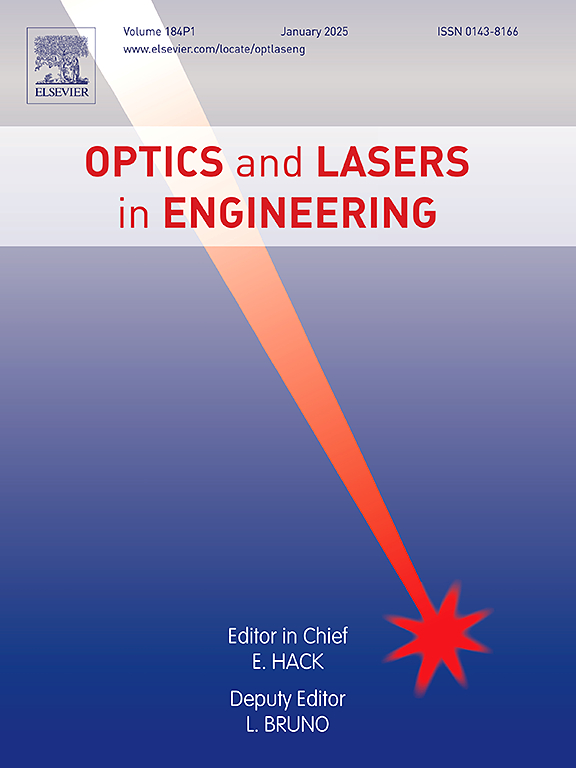膨胀试验下小鼠巩膜应变异质性的立体数字图像相关测量
IF 3.7
2区 工程技术
Q2 OPTICS
引用次数: 0
摘要
巩膜生物力学已成为眼科研究的一个重要课题,特别是对于了解近视和青光眼等疾病的病理生理。对于巩膜组织的生物力学表征,三维数字图像相关(3D-DIC)方法作为一种精确的光学工具被广泛应用于牛、猪、人、大鼠和树鼩等不同物种的离体膨胀测试中全场变形测量,眼睛尺寸范围大致在38 mm至7 mm之间。小鼠已被用作青光眼和近视研究的常用模型,但到目前为止,由于眼睛尺寸小(直径约4毫米),尚未提出用于全眼充气式测试的立体dic。在准静态压力加载过程中,我们首次建立了完整小鼠眼睛的充气测试,通过3D-DIC方法测量巩膜的应变场,并分析了设计立体dic系统所需的变量。此外,我们还研究了小鼠巩膜的生物力学特征,以及在加载-卸载周期中巩膜应变分布的演变。我们发现,在眼内压(IOP)准静态线性变化期间,巩膜应变分布遵循对数正态分布,其标准差代表应变反应的生物力学异质性度量。本文章由计算机程序翻译,如有差异,请以英文原文为准。
Strain heterogeneity measurement of mouse sclera by stereo digital image correlation under inflation testing
Scleral biomechanics has emerged as an important topic in eye research, particularly for understanding the pathophysiology of diseases such as myopia and glaucoma. For the biomechanical characterization of scleral tissue, the three-dimensional digital image correlation (3D-DIC) method has been widely used as an accurate optical tool for full-field deformation measurements during ex vivo inflation testing in different species like cow, pig, human, rat, and tree shrew, with a large range of eye size roughly between 38 mm and 7 mm. Mouse has been used as the common model in glaucoma and more recently in myopia research, but until now, due to the small eye size (∼ 4 mm in diameter), no stereo-DIC has been proposed for whole-eye inflation testing. We present the first setup of inflation testing of intact mouse eyes for measuring the strain field of the sclera by the 3D-DIC method during quasi-static pressure loading, along with an analysis of the variables required to design a stereo-DIC system. In addition, we investigated the biomechanical characterization of mouse sclera, and the evolution of the sclera strain distribution during a loading-unloading cycle. We discovered that the scleral strain distribution during quasi-static linear changes of intraocular pressure (IOP) follows a Lognormal distribution whose standard deviation represents a metric of the biomechanical heterogeneity of the strain response.
求助全文
通过发布文献求助,成功后即可免费获取论文全文。
去求助
来源期刊

Optics and Lasers in Engineering
工程技术-光学
CiteScore
8.90
自引率
8.70%
发文量
384
审稿时长
42 days
期刊介绍:
Optics and Lasers in Engineering aims at providing an international forum for the interchange of information on the development of optical techniques and laser technology in engineering. Emphasis is placed on contributions targeted at the practical use of methods and devices, the development and enhancement of solutions and new theoretical concepts for experimental methods.
Optics and Lasers in Engineering reflects the main areas in which optical methods are being used and developed for an engineering environment. Manuscripts should offer clear evidence of novelty and significance. Papers focusing on parameter optimization or computational issues are not suitable. Similarly, papers focussed on an application rather than the optical method fall outside the journal''s scope. The scope of the journal is defined to include the following:
-Optical Metrology-
Optical Methods for 3D visualization and virtual engineering-
Optical Techniques for Microsystems-
Imaging, Microscopy and Adaptive Optics-
Computational Imaging-
Laser methods in manufacturing-
Integrated optical and photonic sensors-
Optics and Photonics in Life Science-
Hyperspectral and spectroscopic methods-
Infrared and Terahertz techniques
 求助内容:
求助内容: 应助结果提醒方式:
应助结果提醒方式:


